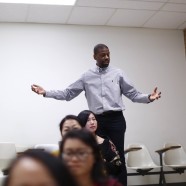
Marvin is an accomplished academic currently teaching as a Full Professor in the School of Business at Portland State University
I view the classroom as a value exchange. Students come to my class expecting something of value in exchange for their time and their money. I come to the class expecting participation and evidence of learning in exchange for a grade. While this seems simple, the value exchange between the students and me vary depending upon the student, the course, and the institution. As such, I have three approaches to understanding the value exchange: know the student, identify the three key objectives, and teach to your strength.
By know the student, I mean that as a teacher, you need to understand the students you are teaching and why they are in your class. Knowing the reasons the students are in front of you will help you to identify their value exchange.
I must admit I adopted the idea of identifying three key objectives from watching the “Fat Albert Show”. At the beginning, of the show, the opening line was “if you are not careful, you might learn something”. This is how I view teaching. First, you must get clear on what the objectives are (survey course, elective, Master’s level, and undergraduate courses all have different objectives) and then you have to decide how you are going to cover these objectives (what type of exercises). Once I know that, I then design a course that covers these objectives in every class. From the Fat Albert show it usually went like this, the gang wanted to do something, their plan went wrong, they were faced with a dilemma, they made the right choice (usually because Fat Albert told them to make the right choice) and then they sang a song about their learnings. I try to teach every course this way. I open up with why we are covering this material (how it fits the objectives), I then prepare my class to cover it, give them an experience (usually an in-class exercise, case discussion or project), and then do a “funny” wrap up (I do not think singing would work, but I do try to be creative).
The last approach is to work to your strength. This objective, I have had to learn over time. My style is very conversational with some lecture (I am sort of a mix between a Baptist preacher and Dr. Phil). I probably lecture more than the average professor, but I think I do it in a style that is not boring and dull. However, I found that because this is my natural style, it seems to work the best. This is why I think I receive high evaluations not matter if I teach 15 or 200 students. Only recently have I learned that my style would be consistent with a “flipped” classroom, in that in almost every class, there is something for the students to do; make a presentation on a case, do a small group exercise, or have a small group conversation. I assume the students have read the material, so there is no need to go over the material.



